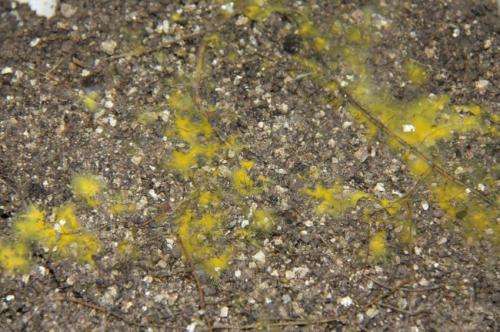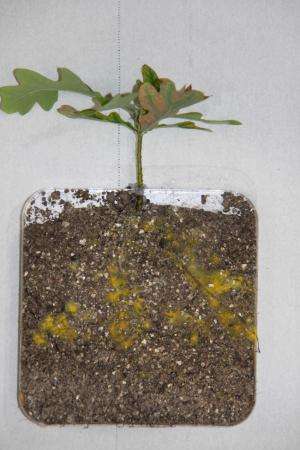Key genes for symbiosis between mycorrhiza fungi and trees evolved several times

This news release is available in German.
Champenoux/ Halle(Saale)/ Leipzig. The life style of ectomycorrhiza fungi is some 100 million years younger than the one of their ancestors within white and brown rot fungi. The key genome adaptation enabling fungi to associate to roots for establishing a symbiosis evolved a repeatedly amount of time. This conclusion was drawn by an international team of researchers who performed the first comprehensive comparative phylogenomic analysis on mycorrhiza fungi, now appearing in the reputed scientific journal Nature Genetics. These sequences provide crucial information on how the symbiosis between fungi and trees evolved.
This will enable scientists to improve their prediction of the reaction of mycorrhizal communities to environmental modifications such as changes in forest management or climate. Three scientists of the Helmholtz Centre for Environmental Research (UFZ) contributed to this discovery that also received support from the German Centre for Integrative Biodiversity Research (iDiv) Halle-Jena-Leipzig.
Living community with broad consequences
Ectomycorrhiza fungi are living on roots of trees, to which they deliver soil minerals in exchange for sugar produced by the plant via photosynthesis. Almost all land plants establish similar kinds of trade with fungal communities of their root vicinity. Mycorrhiza soil fungi play an important role, in terrestrial ecosystems, because they regulate the below round cycling of matter and carbon. In addition, they link different plants together by a common mycelial network that promotes exchanges within the vegetation. Recent studies indicate that mycorrhiza fungi play a crucial role for capturing carbon in soils, which can compensate for the anthropogenic CO2 emissions. For this reason, this kind of symbiosis is not only of interest for biologists and ecologists, but also for climate experts. On the top, ectomycorrhizal fungi include some of the most conspicuous forest mushrooms, including the iconic Fly Agaric, Amanita muscaria, the Black Truffle of Périgord, Tuber melanosporum, one of the most expensive mushrooms worldwide, and the King Bolete, Boletus edulis.
The Mycorrhiza Genome Initiative

In order to understand the principles of symbiotic associations between mycorrhiza fungi and plants, an international team with more than 50 scientists coordinated by the American Joined Genome Institute (JGI) together with the French National Institute for Agronomical Research (INRA) performed the first comprehensive comparative phylogenomic analysis on this fungal group in the frame of the "Mycorrhiza Genome Initiative" (MGI). The study compiles 49 fungal genomes, of which 18 were sequenced for the first time. The 18 new genomes belong to 13 ectomycorrhiza fungi that associate to tree roots, but also include 5 species of further mycorrhiza types on roots of heath plants or orchids. In Nature Genetics the researchers enlighten how a comparative study of the genomes enabled them to retrace the evolution of ectomycorrhiza fungi. In order to understand one of the fundamental genetic change that led to the specific life style of ectomycorrhiza fungi, the team specially emphasized Plant Cell Wall Degrading Enzymes (PCWDEs) encoded by 16 gene families. This focus was inspired by comparing the genome of the first sequenced ectomycorrhiza fungus (Laccaria bicolor) with the one of the first sequenced arbuscular mycorrhizal fungus (Rhizophagus irregularis), which had both been produced by JGI.
Looking back to an earth age older than the one to the dinosaurs
By performing molecular time analyses combining the world wide available genome resources with data on fossils, the team made it to trace back the evolution of plant cell wall degrading enzymes in fungi and to reconstruct at which time saprotrophic and symbiotic fungi diverged from their last common ancestors.
Analyzing the genomes of actual fungi and fossils revealed that compared to white and brown rot fungi that appeared more than 300 million years ago, ectomycorrhizal fungi emerged more recently since less than 200 million years within different fungal lines that continued their parallel evolution. "Ectomycorrhiza symbioses are pretty complex, however analyzing 49 genomes showed that this trait evolved independently in numerous lines of fungi", says Francis Martin from the French National Institute for Agriculture Research (INRA), who is one of the leading author of this study. These data are important to understand how this kind of symbiosis between fungi and plants occurred, from which both partners still take advantage today.
Parallel evolution lines within the fungi
A former common study published in SCIENCE by Prof. Dr. David Hibbett from the Clark University and the JGI described the evolution of the white rot fungi, which are able to degrade cellulose hemicellulose and lignin from plants. Hundreds of million years ago, before the appearance of white rot fungi, fungi were not able to degrade lignin, and this non degraded plant mass was at the origin of the charcoal formation. "Together, our studies tell us how fungi within the white rot first developed complex mechanisms to degrade cell walls, and then partially abandoned this capability in order to develop both the ectomycorrhiza symbiosis and the alternative degradation pathway of the brown rot fungi", Hibbett says.
Genetical innovation engine
"The other big part of this story is that the genome of ectomycorrhiza fungi displays a huge turnover of genes that are up regulated during the symbiosis. Many of these genes have no homologs even in closed related species, which indicates that the emerging of the symbiosis was always coupled with massive genetic innovation. Many of these genes are probably involved in controlling the immune system of plants while the root tissues are colonized by fungi", Francis Martin underlines. The researchers consider that those genes which are necessary to rule the common life between fungi and plants had to be rediscovered repeatedly, because the ectomycorrhiza symbiosis evolved independently in separated fungal lines during the evolution.
Important impulse from Halle/S. and Leipzig
The contribution from central Germany to this international project has several facets. On the one hand, with "TrophinOak" a team of the UFZ in Halle is running since years a DFG granted project on ectomycorrhiza, in the frame of which this symbiosis is investigated on clonal oaks with the fungal partner Piloderma croceum. "Piloderma promotes a particularly strong tree growth and can mobilize nutrients as well from the mineral subsoil as from plant litter. This broad ecological spectrum and the knowhow of our team qualified the Piloderma strain of TrophinOak as one of the 18 fungal species, of which the genome has now been sequenced by the MGI consortium" says Prof Dr. Francois Buscot from UFZ, who is also deputy director of iDiv. The UFZ researchers could rely on the experience of the TrophinOak project, to extract RNA from ectomycorrhiza between Piloderma and the oak. This enabled the team to achieve an expression study that was performed on some of the sequenced fungi, in order to prompt the analysis of the 18 new fungal genomes. Of importance was that the TrophinOak group had already run such expression studies on mycorrhizal oak roots, so that sorting the plant and the fungal transcripts was strongly facilitated. On the other hand, the German Centre for Integrative Biodiversity Research (iDiv) Halle-Jena-Leipzig supported the project with funds for sequencing and analysis. Its international synthesis center sDiv also invited the whole MGI consortium to a workshop held in June 2011 in Leipzig, where the team worked commonly of the Nature Genetics paper. With the help of these new genetic investigations, the researchers hope for the future to better enter into the secrets of the diversity of mykorrhiza fungi and to progress toward a deeper understanding of their role for forest ecosystems.
Journal information: Nature Genetics
Provided by Helmholtz Association of German Research Centres



















